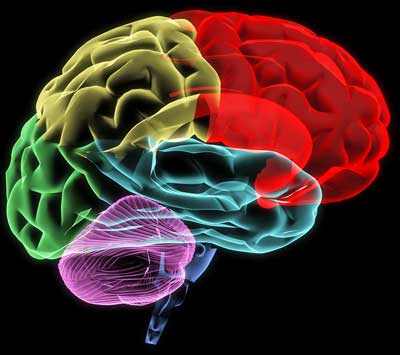Recently we saw that some people appear to be sitting ducks for chronic pain. Their brains have apparently reached a state, unbeknownst to them, where all that’s needed for a chronic pain state to emerge is a triggering event such as an injury. That triggering even starts a process which changes both the grey matter (neurons) and the connections between different parts of their brain
In particular the strength of the connection between two parts of the brain, the prefrontal cortex situated at the top of the brain and the nucleus accumbens situated lower in the brain, played a key role in determining who would experience chronic pain and who would not. The stronger the connection between those two parts of the brain, the more pain was felt.
As we continue our ‘Stress and the Emotions’ series we check out a study that used a different technique to uncover how the brain of a person in chronic pain changes over time in chronic pain.
First they used an fMRI to examine brain activity in people who’d just come down with low back pain and those who’d had it for greater than 10 years. They used a technique, common in these types of studies, that examined the effect different words have on brain patterns. Then they followed the people with recent back pain for a year and examined how the brains of those who got better differed from those who remained in pain.
Results
“We can conclude that perception of back pain in subjects living with the condition for greater than 10 years mainly engages the emotion and reward circuitry.” Authors
Using an approach which involved developing ‘probabilistic maps of brain circuitry for pain, emotions and rewards’, these researchers found that an immense shift in brain functioning occurs in people with chronic pain.
In the early stages of pain the portions of the brain focused on pain and reward are dominant. This makes sense. Pain, after all, is produced in order to shift our behavior in one way or another. Walking on a broken leg induces pain. Staying off that leg induces healing (reward).

After a period of time with chronic pain the brain starts processing pain signals through it’s emotional networks.
As pain becomes chronic, however, the activity of the circuits focused on pain diminishes while emotion-based brain circuits involving the amygdala and basal ganglia grow in strength. The shift appears to be quite significant with the authors reporting that ‘no brain regions‘ in the two groups had similar amounts of activity.
“Brain activity related to back pain shifts from the insula, anterior cingulate cortex, thalamus, and basal ganglia to medial prefrontal cortex, amygdala and basal ganglia.” Authors
The authors note that the ‘perception of pain’ has changed dramatically. While people in the early stages of pain process pain signals through the brains pain and reward pain circuits, people in chronic pain process pain signals through brain circuits identified with emotions and reward.
The New Normal
“Within the first year, the brain carves a chronic pain state.” Authors
This brain circuit reorganization takes place over a year and then remains stable. People with back pain for over 10 years demonstrate the same brain circuitry as those who’ve been in chronic pain for a year. That fits the clinical experiences suggesting that pain which doesn’t get resolved in three months to a year is more likely to be long lasting.
(It should be noted, however, that the time period for the transition from acute (resolvable) pain and chronic (difficult to resolve pain) varies between pain conditions. This study refers to low back pain; other types of pain may have different time periods.
The Set Up
“We postulate that the predisposing characteristics of mesolimbic circuitry at time of pain inception initiates a cascade of emotionally-driven learning events that effectually reorganize the brain into a chronic pain state with distinct functional, anatomical, and resting state properties.”
Remarkably, this transition from acute to chronic pain, and from pain focused brain circuitry to emotion focused brain circuitry, can all be predicted by the strength of the connection between two parts of the brain called the prefrontal cortex and the nucleus accumbens.
Mood Disorders Do Not Predict Shift
Given the general understanding that anxiety and depression exacerbate pain, the authors expected this shift in brain circuitry would be more prominent in people with anxiety and depression, but neither of these mood disorders affected the shift at all. The shift was predicated on the strength of the prefrontal cortex-nucleus accumbens connection, not the presence of anxiety or depression. The stronger the connections between those two parts of the brain, the more likely someone was going to transition from acute to chronic pain.
Prefrontal Cortex – Nucleus Accumbens Circuit
The prefrontal cortex carries out ‘executive functions’ such as working toward a defined goal, predicting outcomes, and managing expectations. People with poor executive function (such as people with ME/CFS) have more difficulty planning complex activities and decision-making. The nucleus accumbens plays important role in how much pleasure, fear, aggression and impulsivity we experience.
The idea that pain signal processing has moved from the sensory pain circuits in acute (short-lived) pain to brain circuits involved in emotions and reward is obviously an important one. Making sense of what this means, however, is difficult given the technical language used in this text. (At one point they end up quoting the philosopher Ludwig Wittgenstein.)
Emotionally Driven Learning Events?
“Predisposing characteristics of mesolimbic circuitry at time of pain inception initiate a cascade of emotionally-driven learning events that effectively reorganize the brain into a chronic pain state with distinct functional, anatomical, and resting state properties.”
At one point Apkarian calls the idea that people in chronic pain simply conflate fear and sadness with back pain a ‘highly artificial one’. They note that the amygdala — one of the brain regions that’s enhanced in chronic pain — is oriented to motivationally relevant and more powerful stimuli, while the prefrontal cortex assigns meaning to sensory cues based on past experiences.
The authors may be suggesting that in chronic pain an over-active prefrontal cortex assigns enhanced meaning to sensory cues that involve pain and then shoots them to the amygdala, which amplifies them with enhanced emotional content. We should remember that pain is both a sensory and an emotional experience.
They end the paper stating:
“We interpret the observed spatial shift in back pain representation as evidence for the pain percept reflecting less its sensory properties and instead becoming a heightened and more complex emotional state, constructed from learning and resultant memory traces of the presence and persistence of the condition, which orient the motivational preferences of the subject toward ‘suffering’ with the condition.”
Your interpretation of this confusing statement is as good as mine. My guess is that Apkarian is simply saying that after a time the brains of people in chronic pain have ‘learned’ to be in more pain; pain has, so to speak, been integrated into their experiential DNA and a complex emotional state has evolved. One might ask how some of most severe and unpleasant sensations we can experience could not at some point become part of a ‘complex emotional state’.
The authors state that this ‘pain train’ orients the ‘motivational preferences of the subject towards suffering’ – another statement that’s hard to decipher. How, after all, could one’s ‘motivational preferences’ orient one towards suffering?
My experience suggests that pain memories can get so locked in that when we look to our future all we see is pain. That upset, by itself, may trigger the sympathetic nervous system to increase pain sensitivity. For example, I experience muscle rigidity, shortness of breath, irritability, and more pain in general when I’m under stress. I believe I’m shutting off blood flow (and thereby oxygen) to various parts of my body.
That scenario is the foundation of a hypothesis by Dr. Manuel Martinez-Lavin regarding pain production in FM, and he has some genetic evidence to support his hypothesis. (Dr. Martinez-Lavin examines the same adrenergic system that’s focused on in the latest POTS autoimmune study.)
Do emotions or stress affect your pain levels? I know they do affect mine, but it can be hard to distinguish whether my emotions and stress affect the pain or vice versa. For me both clearly are involved.
How to get out of the pain is another question. If chronic pain is partially the result of an overactive brain circuit then changing the strength of that circuit should help and that is an area of active research.








Great article, thanks Cort!
Another fantastic post Cort!
I can absolutely say that any high emotion (good or bad) will cause me physical pain. Even cause a nasty pain flare (sometimes lasting days).
So I really (and I mean *really*) try to keep a calm outlook on life. I cannot afford to become over excited in any way. Feeling angry, stressed, aggravated, overly annoyed (noise I can’t stop, for instance), or excessively sad/depressed will cause me physical pain. Every single time.
I can believe that there is a difference between “living” your pain (where it takes over your thoughts and is all you can think about – especially after a trauma of some kind or being newly diagnosed with FM/ME) and “feeling” your pain, emotionally. I can also believe that after a year or more of living your pain, you then teach yourself to feel things more emotionally. After all, your body has been in constant stress for a very long time already. And muscles “remember” their state.
Is there any wonder why I strive to remain calm and unaffected as much as possible? I think not. It’s a survival tactic I have no real choice in.
Shannon @ http://www.livingwithfibromyalgia.ca
I am not sure physiologicaly how but I have a theory which seems to relate to this line of thinking. I believe in Fibromyalgia there is a connection to a pain memory storage part of the brain. Similar to old memories popping into your mind whether due to a noticeable trigger or whatever; I often experience pain from the past. It exactly mimics pain I have experienced at a prior time. Whether it is a childhood playground injury or a later life car accident injury, any significant pain that became defining can come on at any time. An old ankle injury can cause me to almost fall and not be able to put pressure on my foot. A few steps later it may be fine. Logically, I know it is not a “real time” pain but it produces the same result. There are multiple unexplained pains suffered with fibromyalgia in addition to general muscle pain type. These pains are unique to each person. It just makes sense to me that there is a different or extra path in use.
I think memories play a role. We seem to be more susceptible to stuff like this, which is one reason I think cognitive aspects of FM and ME/CFS are important. There have been times when just thinking about a pain can bring it on. It’s as if the fear processes of the brain are winging away- saying ‘watch out’. When I’m in my healthier states it doesn’t happen and coincidentally I’m much clearer cognitively as well; create enough good energy and those problems dissolve.
Cort,
Great piece of writing. As someone who has read Dr. Apkarian papers and tried to distill his work, I am in awe of your abilites.
Thanks Tim. We both know how rough this stuff can be. 🙂
Fascinating! Excellent write-up! Going to post for some of my old psychology friends. I used to work in neuro-psych. Still do…a tiny bit.
We really need sub-sets! I feel like I am reading about a totally different condition!
Very Interesting Cort.
Us ME/CFS folks often feel that we’re being singled out for cognitive therapy ‘cures’ but much of CBT research is derived from studies of lower back pain. Doctors don’t like it when patients don’t recover as expected or they complain of symptoms ‘out of proportion’ to their condition.
It does seem though that the pre-frontal cortex plays a role in ‘modulating’ the emotional response to chronic pain and its this ‘top-down’ inhibition of the response to noxious stimuli that informs a lot of CBT approaches. Its a pity that value laden terms such as ‘catastrophising’ or ‘false illness beliefs’ litter the field.
Its a complex area though. I wonder to what extent the above study controlled for the continued presence (or not) of a physical injury and how ‘new’ the patients were. After all you must have had back pain for quite a while before self-referring to a medic so the enhanced brain connections may already have been established in response to pain rather than just a ‘trait’.
Its interesting to note that reductions in the pre-frontal cortex grey matter found in chronic pain patients is reversed following surgery that effectively ‘cures’ the while its claimed that CBT that reduces pain and ‘catastrophising’ also results in increases in pre-frontal volume (even beyond normal controls which suggests an enhanced adaptive resource).
There’s some debate though whether the claimed effects of CBT are long lasting and whether reduced pain leads to increased grey matter volume or increased grey matter volume reduces pain perception :
http://www.painresearchforum.org/news/34218-cognitive-behavioral-therapy-changes-gray-matter-morphology-chronic-pain
Its worth bearing in mind though that cognitive approaches can only reduce the secondary ’emotional’ response to pain – not the pain itself and there are other approaches such as mindfulness that may be just as effective and don’t carry any ‘blame the patient’ baggage.
Actually I’m sure most Drs recommending CBT and most CBT practitioners don’t ‘blame the patient’.
Good points Marco. Doctors want to be successful at what they do and they want to help.
That’s a good question about physical injury and about time frame. I don’t know about physical injury; I do know that imaging results often do not correlate with the degree of pain experienced, but that’s an imnportant question.
Time-frame – I think they were looked at within three months of the start of their pain, so it wasn’t necessarily immediately.
I am not sure physiologicaly how but I have a theory which seems to relate to this line of thinking. I believe in Fibromyalgia there is a connection to a pain memory storage part of the brain. Similar to old memories popping into your mind whether due to a noticeable trigger or whatever; I often experience pain from the past. It exactly mimics pain I have experienced at a prior time. Whether it is a childhood playground injury or a later life car accident injury, any significant pain that became defining can come on at any time. An old ankle injury can cause me to almost fall and not be able to put pressure on my foot. A few steps later it may be fine. Logically, I know it is not a “real time” pain but it produces the same result. There are multiple unexplained pains suffered with fibromyalgia in addition to general muscle pain type. These pains are unique to each person. It just makes sense to me that there is a different or extra path in use.
Hello Cort,
Problem with all of this is that we still must get at the root of the problem. (I feel like yelling about this, but I won’t.) Brain changes are not causing the pain. I’m a good example of this, and I wish I weren’t. I got something like meningitis eight years ago. I have had a constant headache 24/7 ever since. I now have almost all my cytokines elevated indicating severe inflammation. I have many IgG titres for many viruses elevated. None of this was the case prior to the meningitis, even though I had Lyme disease for 10 years prior to that. I don’t want to be told my brain is perpetuating the pain. My brain would be happy to give up this pain, if someone would kick out the ongoing cause.
🙂
Hi Paula,
Have you heard of the Cefaly device made to reduce headaches.It is approved by the FDA. User wears it 20 minutes a day.
Its a battery powered deviceand does’nt have any known side effects.
There is a Cefaly website.
I hope this is Helpful
cheers Judy
Great article. I’m seeing some pretty remarkable results with my psychotherapy clients and meditation students when teaching them mindfulness meditation and gentle yoga for pain reduction. There’s a good body of research out there now, too, about mindfulness, yoga, and pain reduction, indicating that many people experience either a reduction in pain and/or an increased capacity for coping with existing pain. Also some good research on mindfulness and decreased fatigue for folks with CFS, MCS, and fibromyalgia. I love teaching mindfulness and yoga and bearing witness to people once again feeling more empowered to have a positive impact on their sense of well-being after sometimes years of feeling so unwell. Glad to have stumbled onto your blog that a colleague posted on LinkedIn.
I resolved five years of persistent pain with a mindbody approach from John Sarno. A more “scientific” adaption of his ideas is called “pain processing therapy.” A recent peer-reviewed trial on pain processing therapy showed it resolves persistent pain as the norm. Education is the key. Not drugs.